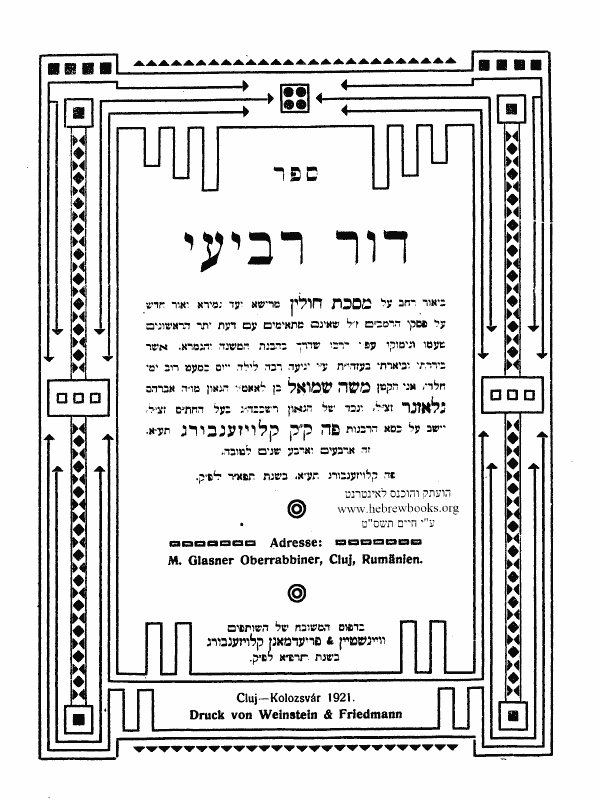The question whether a tereiphah can live gives rise to a Talmudic dispute. One opinion holds that a tereiphah can live ( טרפה חיה ) and another opinion holds that a tereiphah cannot live ( טרפה אינה חיה ). The question is generally related to the 18 tereiphot that are enumerated in the Talmud as halakhot le-moshe mi-sinai, and the widely held opinion is that the dispute between these two opinions is whether, indeed, any animal with these conditions is incapable of living more than a limited time. The time that it can live, according to the opinion that טרפה אינה חיה is presumably more than 24 hours, but less than a year.
The Dor Revi’i in his petihah, iqarim 9 and 10 (which I hope to post over the weekend) challenges that common understanding of what the question whether a tereiphah can live. But in this post, I just want to highlight what he says concerning that question is his comment on the Tosaphot on 37a (ד”ה שאינה חיה לא תאכל ). The Mishnah at the top of 37a discusses the status of mesukent, an animal whose general weakness is such that its death is imminent. According to the Mishnah a valid shehitah renders the flesh of the mesukent permissible to be eaten. The Gemara, however, suggests that eating the flesh of such an animal would be contrary to the verse (Leviticus 11:2) זאֹת הַחַיָּה אֲשֶׁר תֹּאכְלוּ which the Gemara suggests should be read to prohibit the flesh of any animal that is about to die, e.g., a mesukenet. The Gemara, however, concludes that this verse should not be be understood to prohibit the flesh of a mesuket (though eating the flesh of a mesukenet would certainly not be a smart thing for anyone to do).
Commenting on the Gemara’s citation of this verse, the Tosaphists observe that this verse is relied upon in the next chapter of the tractate “Eilu Tereiphot” as the textual basis for prohibiting the 18 tereiphot. This comment draws the attention of the Dor Revi’i.
תוס’ ד”ה שא”ח לא תאכל, בריש א”ט דרש מהאי קרא דטא”ח והיינו לפי המסקנא דהכא, דלא מתוקמי במסוכנת, עכ”ל. מה שכ’ התוס’ דלפי המסקנא דהכא אתא קרא ד”זאת החיה” על טא”ח הוא פלא והפלא, דדבר שאפשר לידע הוא אם ט”ח או טא”ח, ולא מצינן קרא על דבר טבעי שיש לעמוד עליו, הא חדא. שנית דעדיין לא נדע מה קרי לי’ טרפה, וצ”ל דעל הלכה קסמך דהני ח”י מכות מטריפין, ואתא קרא לפרש ההלכה כזאת לא נמצא. ועוד בו שלישית דלמאי נפ”מ לידע זאת, דהני דמנה ההלכה שהמה טרפיות, אם מצי לחיות או לא, דהרי המה טרפות בין חיין ובין אינן חיין. ואין כאן נפקותא אחרת אלא לגבי ספק טרפה אי מהני שהיית יב”ח, וכמש”כ הרשב”א והר”ן ז”ל בריש פא”ט. וזאת ודאי ענין דרבנן הוא, דמה”ת בלא”ה ספק טרפה שרי’. לא מבעי לדעת הרמב”ם דכל ספק מותר מה”ת, אלא גם לדעת הרשב”א, הלא ספק במקרה שרי.
The Dor Revi’i questions the assumption of the Tosaphot that the prohibition of the 18 tereiphot can be inferred from the verse זאֹת הַחַיָּה אֲשֶׁר תֹּאכְלוּ , and assumption that he considers astounding ( פלא והפלא ) for three reasons.
First, there is no basis for assuming that a factual question ( דבר שאפשר לידע ) can be answered from Scripture, because (לא מצינן קרא על דבר טבעי שיש לעמוד עליו). There is no Scripture from which we can deduce reliable knowledge about the natural world.
Second, the 18 tereiphot are not specified in Scripture. We know them only through halakhah le-moshe mi-sinai. It is therefore impossible to assume that the understanding of the properties of the the 18 tereiphot can be deduced from the Scripture, because it is the Oral Law (halakhot le-moshe mi-sinai) that interprets the Written Law not vice versa (ואתא קרא לפרש ההלכה כזאת לא נמצא).
Third, once the 18 tereiphot have been specified by the halakhah as prohibited, it is irrelevant whether animals with those conditions could live beyond some arbitrary time limit.
Thus, the only reason why there is any dispute among the Sages about whether a tereiphah can live or cannot live is to resolve a doubt concerning an animal that is a sapheq tereiphah (i.e, an animal suspected of being but not proven to be a tereiphah). In such a case, the question in dispute is whether the fact that the animal survived for 12 months would resolve the doubt concerning its status. The opinion that says that tereiphah can survive holds that survival for 12 months does not change the status of the animal as a sapheq tereiphah, because a tereiphah can in fact survive for 12 months. The opinion that says that a tereiphah cannot survive holds that survival for 12 months is a sufficient basis for resolving the doubt concerning the animal’s status.
